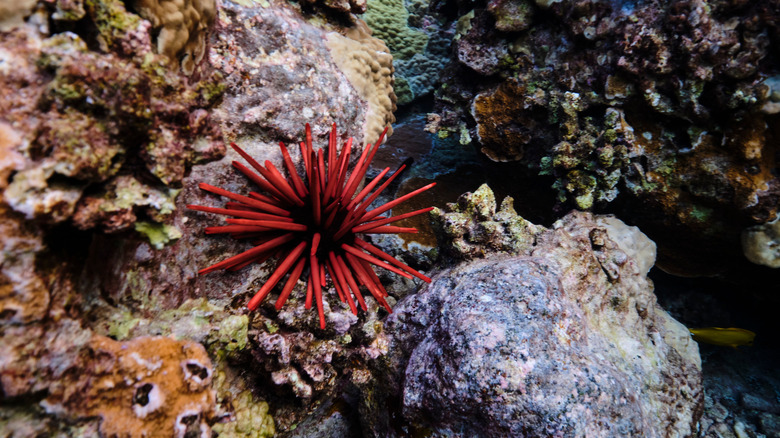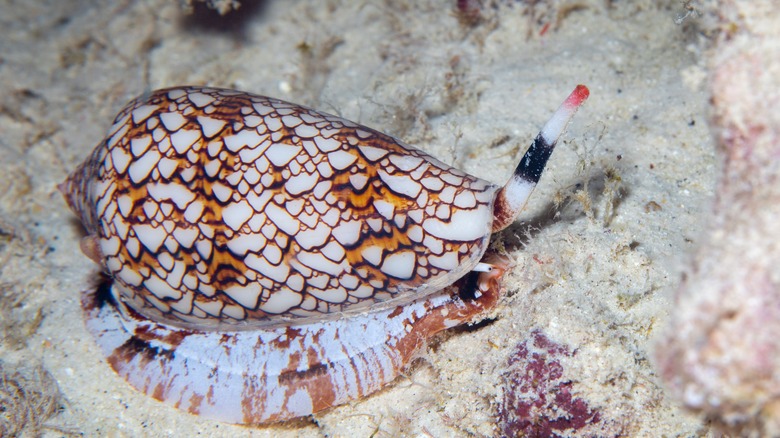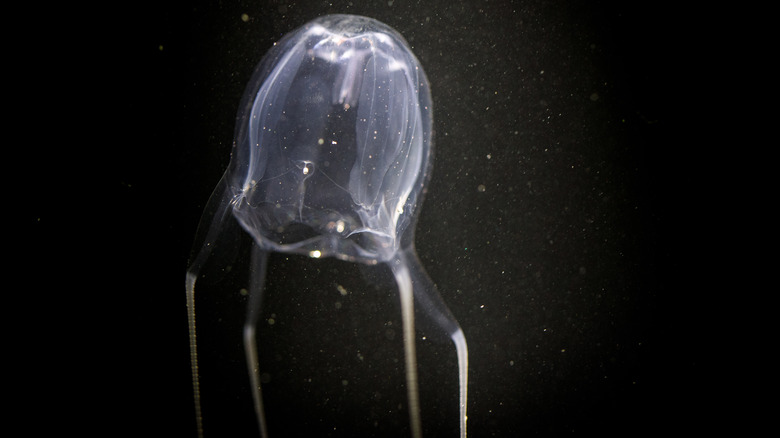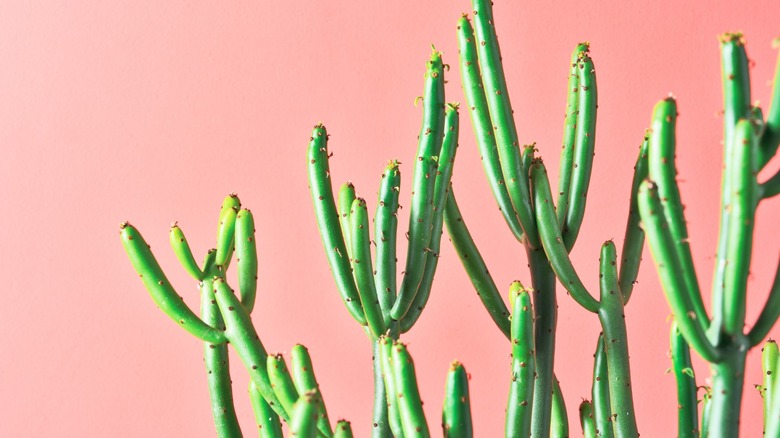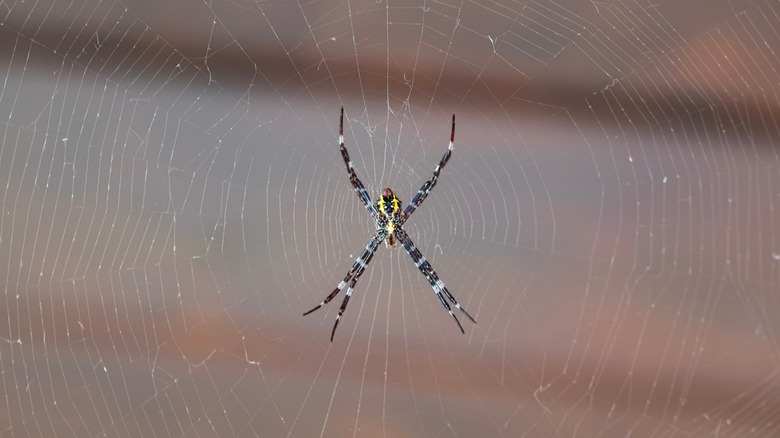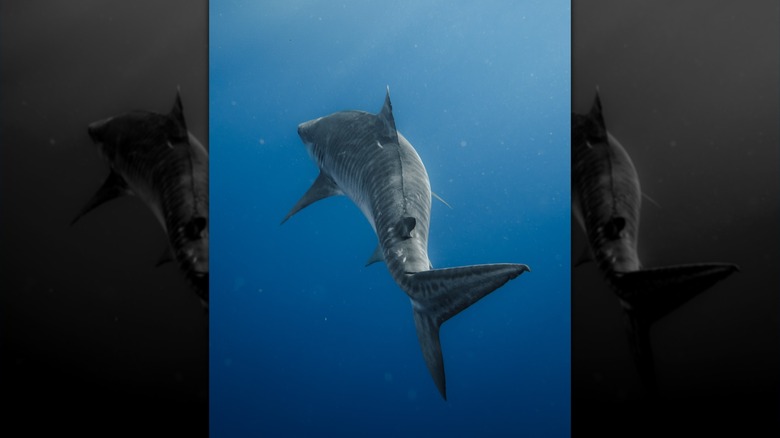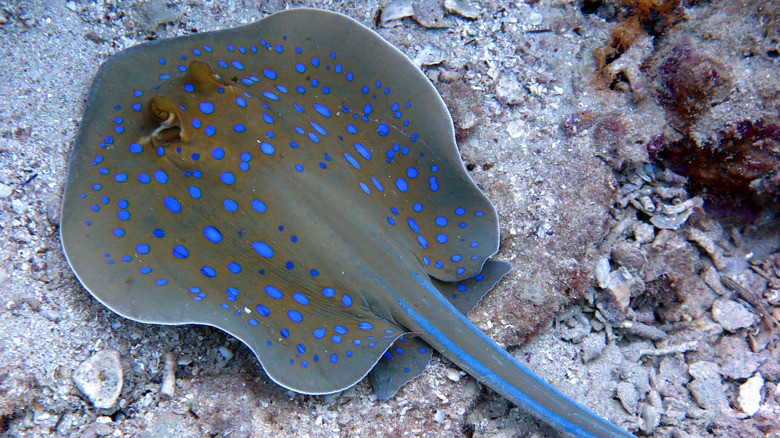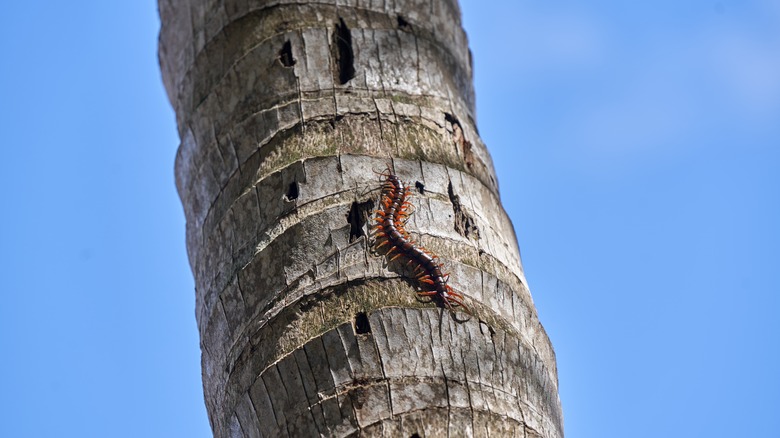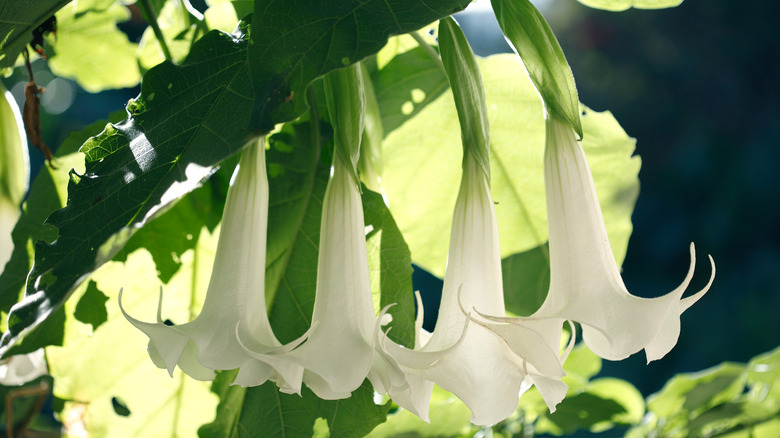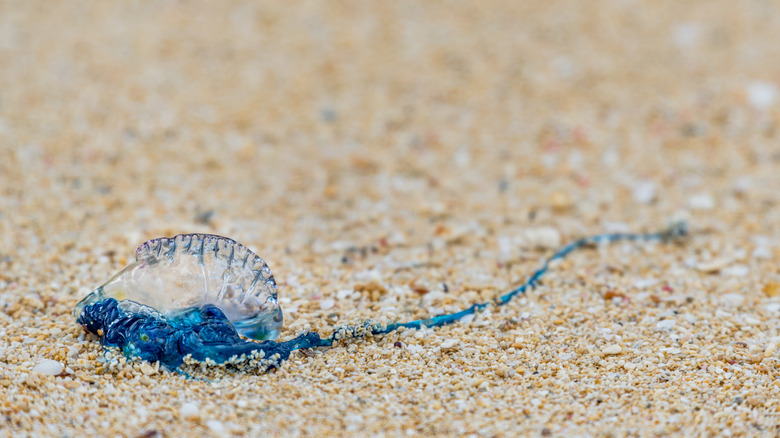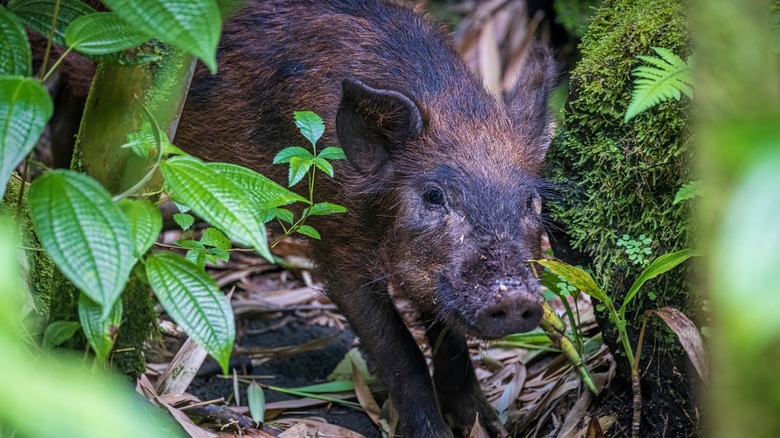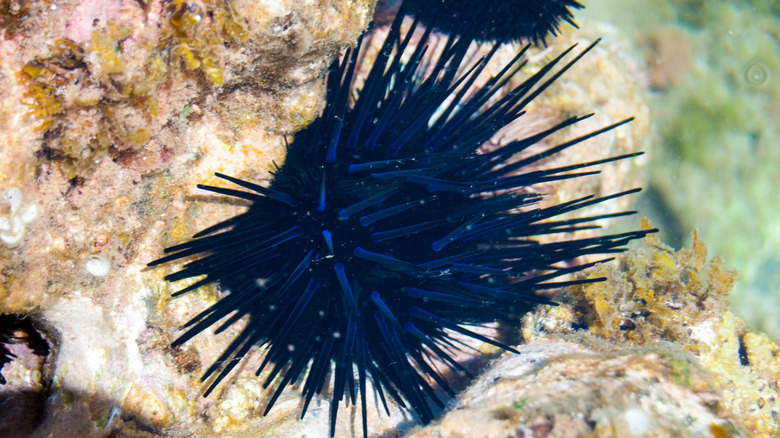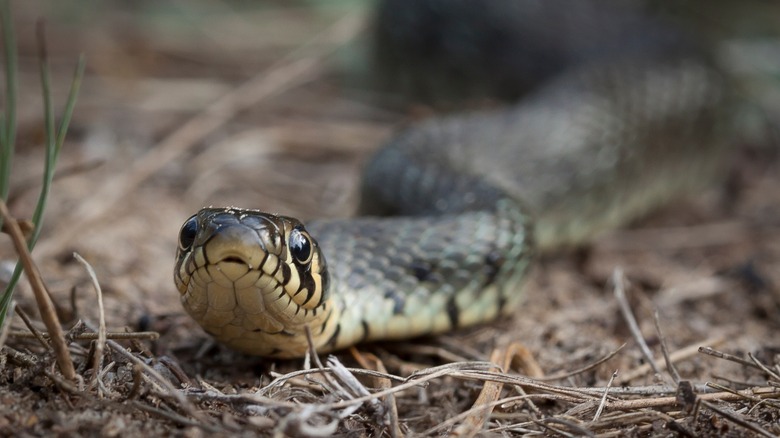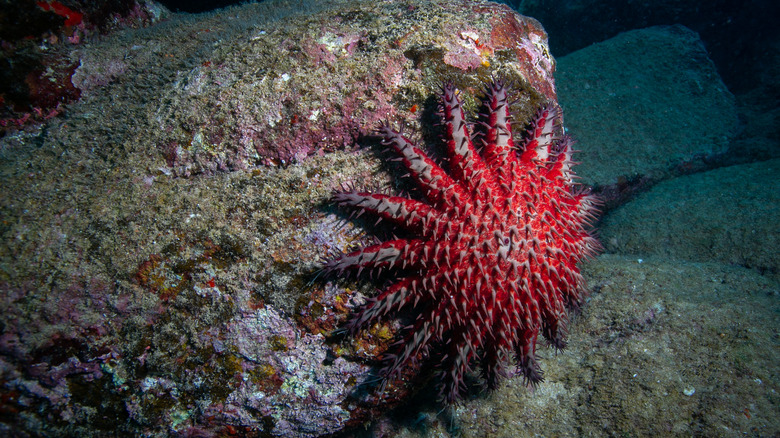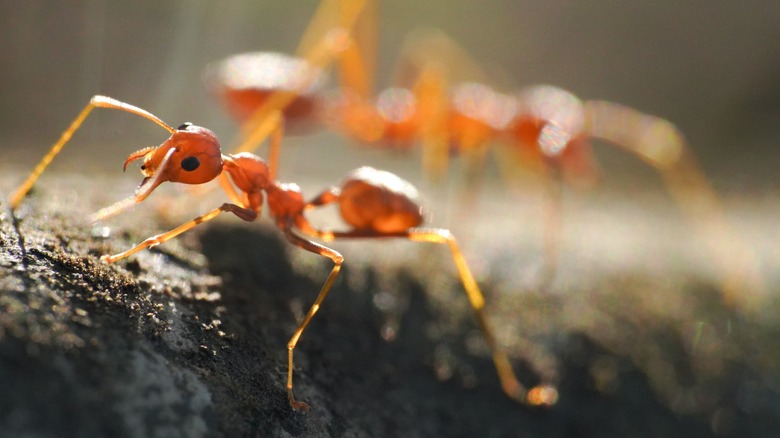Hawaii's Most Dangerous Wildlife And How To Avoid It On Your Vacation
As part of their pre-travel prep for a holiday in Hawaii, the average tourist might typically be keen to brush up on their knowledge of local Hawaiian slangs or tourist traps to avoid, to better blend in with the spirit of the island paradise. Given that the Aloha State is an ecological haven, there is another very significant aspect of vacation planning that often goes ignored but requires equal, if not more, attention: information about wildlife dangers to avoid.
Hawaii is home to hundreds of wild and wonderful living species — some native, others invasive — that come together to contribute to the island cluster's rich biosphere. Exquisite as each of them might be, they are not all sociable with human explorers and can turn hostile if provoked. That said, it's only fair to remember that these beasts — no matter how scary-looking — are not natural human predators and regarding them from a respectful distance will almost always guarantee safety. While Hawaii might not exactly be one of the most dangerous islands in the world, here's a handy explainer on how to avoid its unfriendly wildlife.
Cone Snails
For a variety of reasons, some of Hawaii's beaches are considered among the world's most dangerous. So if you see a pretty cone shell on the beaches of Hawaii, it's best not to pick it up as a souvenir. There could be a snail inside that you don't want to mess with. Unassuming as they may seem, cone snails are among the world's most venomous animals and a single sting from this creature of the sea can be enough to cause dire consequences like paralysis, respiratory failure, and in some cases, even death. They customarily go after fish, worms, and other small prey, but can just as easily bring out their stingers for anyone who aggravates them.
Given the spread of over 30 species of cone snails across the Hawaiian islands — and the fact that all of them are capable of releasing venom — the dangers they pose are persistent and real. Since their intricately designed shells and slow-moving disposition don't exactly scream menacing, their hazards may not be immediately apparent. But even the local name for them — poniuniu, which literally means dizzy shell — is nothing short of a forewarning about the threat sea snails carry. Divers, beachcombers, and shell collectors are most likely to encounter cone snails during their underwater or shoreline expeditions and should be extra careful about where they put their hands and feet.
Box Jellyfish
Jellyfish are some of the most ethereal beings to look at underwater — look being the operative word. For, one sting from these translucent sea jellies can put a major damper on your beach vacation. In Hawaii, the box jellyfish reigns supreme and, as the National Geographic notes, produces venom that is "among the most deadly in the world, containing toxins that attack the heart, nervous system, and skin cells." So pretty much everything that keeps us alive. A box jellyfish's sting can cause a distinct condition called the Irukandji syndrome, which can trigger symptoms like nausea, blood pressure issues, cardiac arrest, and even eventually prove to be fatal.
Jellyfish attacks are not uncommon in Hawaii where in early 2023, over 150 people were stung by these marine marvels around Honolulu in a single day, according to Hawaii News Now. While no deaths were reported, the incident reiterated the need for beachgoers to exercise extreme caution on the shores of Hawaii, given the booming box jellyfish population in the Indo-Pacific waters. The severity of the sting typically correlates to the size of the jellyfish — larger specimens can deliver stronger blows — but you would be better off avoiding the whole assortment. Look out for warning boards around the beaches of Hawaii and double-check with local lifeguards about jellyfish occurrence in the area before entering the water.
Pencil Plant
Over on land, Hawaii's pencil plants command an intriguing status. These slender succulents — easily identifiable by their distinct finger-like branches — are found across the Pacific islands, reaching out into the sky in all their spindly glory. Their unique foliage is no doubt appealing to the human eye, and explains why the wild tree is often contained in flower pots as an ornamental indoor cactus. This is where it gets tricky, because the harmless-looking pencil plant is actually quite toxic in nature.
Pencil plants secrete a milky white sap that can prove caustic to humans upon skin and eye contact, leading to irritation, inflammation, burning, or even temporary blindness. The consequences can end up being especially severe for people who consume this latex. The pencil plant shows up as a repeat offender on the Hawaii Poison Hotline's list of plant inquiries. Interestingly, despite its reputation as a noxious entity, it remains a popular choice among plant parents. If ever you are invited by one to admire their precious greens, it would be wise to do it from afar.
Spiders
Spiders are abundant in Hawaii, each with an identifier nickname more creative than the last — from the spiny-backed orb weaver, to the happy-faced spider, and, believe it or not, giant daddy-long-legs. While these specimens can hardly be categorized as friendly, the ones you should be keeping an eye out for on your Hawaiian holiday are those that have dangerous bites.
Hawaii's Department of Health warns particularly against the black widow spider and brown widow spider, both of which can cause severe symptoms like nausea, fever, cramping, and respiratory issues. The Mediterranean recluse is another spinner to be wary of, especially since, as its name suggests, it is adept at concealing itself in dark spaces. The daring jumping spider is no pal to humans either.
Over a hundred spider species are native to Hawaii but several more were introduced to the island nation and are now invasive beyond control. It can be easy enough to come across spider species in Hawaii, either out of doors in secluded crevices where dust tends to collect or in musty corners indoors. Try not to stick your hand into dark spaces or walk into a cobweb.
Tiger Sharks
Sharks are preceded by their reputation as some of the deadliest underwater predators. The island nation of Hawaii would probably disagree with that generalization. Though the Pacific waters are home to a multitude of shark species — including the notoriously aggressive tiger sharks – the State of Hawaii maintains an ungrudging approach toward them, categorically highlighting in an official release how "in Hawai'i the chances of being bitten by a shark are less than one in a million."
This prudence could be attributed to the fact that sharks are sacred to native Hawaiian culture, revered locally as aumakua or family guardians. The status they enjoy on land, however, has not deterred Hawaiian sharks from acting on their predatory instincts. Unprovoked shark attacks are not unheard of in Hawaii, especially given the prevalence of tiger sharks in the area, one of which even killed a lifeguard off the island of Oahu in 2024. While the danger of sharks in Hawaii is definitely not unwarranted, it is our prerogative as human explorers to secure our safety on all fronts, make sure the waters are clear, and be respectful of marine life while venturing into their territory.
Broad Stingray
The waters of Hawaii have an abundant population of broad stingrays that, like other members of the ray family, are a typically shy bunch of underwater denizens. They like to keep to themselves, usually busy with foraging small fish, worms, and other crustaceans around reefs or sandy bottoms. Understandably enough, broad stingrays don't like to be disturbed and, while they are not prone to aggression, can use their stingers if they feel threatened.
Divers and swimmers especially should be on the lookout for stingray attacks, which are far and few between but still possible if these gentle giants are accidentally stepped on or deliberately provoked. The long tail spine that protrudes from a broad stingray's flat body is its weapon of defense and when used, can pierce the skin and cause an extremely painful injury. Wildlife conservationist Steve Irwin's death is often cited as a cautionary tale of just how dangerous stingrays can be but beyond the sensationalism, stingray attacks are rarely ever fatal. Watching a stingray glide through the wild blue can be a breathtaking moment. But it's a natural wonder best witnessed from a safe distance.
Giant Centipedes
Hawaii is home to many species of centipedes, which are reigned over by the most dangerous of them all: the giant centipede. As the name suggests, this multi-legged critter is the largest of its kind and commensurately terrifying. While the less deadly varieties are also bracketed as pests that can slither into your home and cause a nuisance, the giant centipede is the one you will want to pointedly look out for (with the purpose of avoiding) on your Hawaiian holiday. That is not to say the giant centipede cannot come crawling into your space!
As wild citizens of the tropical island, Hawaiian centipedes roam freely everywhere. But it is worthwhile to note that they are probably more intimidated by us than we are of them. A sting from a giant centipede can cause severe pain and inflammation that can affect the victim for hours together, but wouldn't typically be fatal. By virtue of our physical advantage over them, we pose a far greater mortal threat to centipedes, who will often try to escape instead of confronting a human. It won't hesitate to strike if threatened though.
Angel's Trumpet
Angel's trumpet: It has an otherworldly ring to it and, to its benefit, even looks as beautiful as it sounds. This benefit, however, does not extend to humans — especially those who come in contact with this innocuous-looking plant. Boasting unique bell-shaped flowers that hang upside-down from its branches, the angel's trumpet is a deadly specimen found in the Hawaiian wild that contains certain alkaloids that can induce a heightened hallucinatory state in anyone who, for whatever reason, consumes it.
A psychedelic trip brought on by the angel's trumpet – sometimes commonly referred to as datura — is hardly pleasant and can quickly devolve into paranoia, seizures, respiratory issues, paralysis, and in some cases, even death. To eliminate any room for a misstep, it is best to not touch the plant or even remain in its proximity longer than necessary. Despite the plant's long stack of dangers and a wealth of published research cautioning against engaging with it, angel's trumpets are surprisingly found in abundance as garden ornaments across homes, increasing the risk of exposure. Before heading to Hawaii, make sure to familiarize yourself with what the angel's trumpet plant looks like, so you can actively avoid it.
Man O' War
The Portuguese man o' war is an exquisite being that might compel you to inspect it closely. And on the sandy shores of Hawaii — where this jellyfish relative can be found washed up, along with other underwater surprises the waters sometimes deposit on the beaches — you are likely to get a chance to put your curiosity to rest. As appealing as the idea of inspecting (or worse, touching) the man o' war's transparent body may first seem, we strongly advise you against venturing near it because it only looks like a docile little plastic baggie.
The man o' war — or bluebottle, as it is alternatively called — has long tentacles that can deliver a sharp sting as a defense against any sort of threat, real or perceived. While an interaction with a man o' war will not turn deadly, the pain could be intense enough to stay hours or even days after the sting. While swimmers should take the precaution of ensuring that there are no man o' wars lurking in the ocean before jumping in, beachcombers must be equally vigilant of these iridescent creatures lying around on the beach. A man o' war can sting even days after being out of the water.
Feral Pigs
An unlikely danger on a list of potentially lethal species, the feral pigs of Hawaii are apparently a huge problem for the island paradise. Their ancestors were first introduced to Hawaii over a thousand years ago by the Polynesian people, following which the British explorer Captain James Cook set another strain of pigs free on Kaua'i in the 18th century, leading to the evolution of a wild and wonderful island resident. Hawaii's other inhabitants will probably not agree with the wonderful part, given the destruction these feral pigs are known to cause.
Feral swine occupy a majority of Hawaii's inhabited islands, where they act as a means for the spread of mosquito-borne diseases and invasive plants, wreaking havoc on the flora-fauna ecology. Hawaii's feral pigs can just as well attack people, especially if they feel endangered in any way. Since they roam the island freely — all the way along the beaches and roads and private properties — it is not uncommon to come face to face with them on a random day. If you do, back down. You don't want to trigger an angry response from these wild beasts.
Sea Urchins
There are plenty of sea urchins roaming the waters of Hawaii and, while not all varieties are venomous, you are better off not testing your luck by venturing near them. As a general rule, if you see a spiky creature minding its own business underwater, do not disturb it. In Hawaii, long-spined sea urchins — known locally as wana — are the ones to be especially wary of. As the name suggests, they have extended spokes jutting out of their outer body that look as daunting as they can actually be.
Sea urchins typically hang around shallow reefs and rocks, and while they aren't willfully seeking out human prey, it's quite possible for divers, surfers, and snorkelers to come in contact with them accidentally. Touching or stepping on one of these otherwise peaceful submarine grazers can puncture the skin — sometimes even through wetsuits and other protective gear — and cause a painful sting. Aea urchin spines break off during an attack and can remain lodged in the wound until they are surgically removed or alternatively dissolved with vinegar. Fortunately, these are wholly avoidable scenarios if you mind your step while entering their home.
Snakes
Unfortunately, Hawaii isn't like Iceland, one of the only countries in the world without snakes. It's interesting, however, that the island paradise has mostly been spared the terror of one of nature's most feared reptiles: snakes. There are no snake species native to Hawaii, although that does not mean the country is totally unfamiliar with these slithering beasts. Some like the brahminy blind snake and the brown tree snake have been known to roam Hawaiian lands, albeit as nonthreatening invaders of the island.
Out in the water, however, the yellow-bellied snake does warrant a degree of caution. This highly venomous species is not endemic to Hawaii but owing to its spread across the Pacific Ocean, encountering one off the coast of the Aloha State is not unexpected. If you do spot one while swimming, snorkeling, or diving, keep your distance like the snake will keep its own. Hawaii so far has not reported any yellow-bellied snake bites but you can best believe that aggravating this generally peaceful sea serpent might trigger an angry reaction that could be fatal. The waves can sometimes wash these underwater creatures ashore, so beach loungers must tread carefully, too.
Crown-of-Thorns Starfish
The crown-of-thorns starfish is the deep sea embodiment of a dangerous beauty. More commonly (and conveniently) called COTS, it's a kind of sea star that can typically be found underwater, latched on to a coral with its arms — which can go up to a count of 20 or more — gloriously spread out. Though the starfish's vividly colored body might suggest otherwise, it is hardly a decorative accessory and sprawled out on live corals like that, is actually feasting. COTS' predatory instincts are a natural component of the submarine ecosystem but can turn ferocious during outbreaks, often overwhelming the reef biosphere in an area.
COTS aren't too friendly with humans either. The presumption is that divers who do manage to spot this unique animal — which can be found in abundance around Hawaii and Australia — will not be compelled to touch it, given the deadly-looking spikes that protrude from it. COTS' spiny outer shell is not for show and contains venom that can be harmful to those who come in contact with it. While the sea star will not actively seek out humans to attack, even an accidental brush with it can cause injury, warranting extreme caution on the part of divers venturing down below.
Little Fire Ants
Little fire ants are proof that size doesn't matter when it comes to making a memorable impact. Even a small sting from one of these guys packs a powerful, painful punch that can leave your skin irritated for hours or, if you are unluckier, days. While a tiny insect seems like an unlikely addition on a list of dangers that includes predators like sharks and snakes, little fire ants, in the words of Hawaii's Stop the Ant campaign, should not be seen as "just another ant." This species is notorious for being one of the world's most dangerous ant types.
These tiny stingers are found across Hawaii and, though not native to the island country, have cracked the code to making their presence felt as an invasive species. Once an army of little fire ants take over a space, it can be hard to get them to leave, with pest control often having to step in. A holidayer in Hawaii will probably not have to worry about a residential infestation but given that these tiny troublemakers roam the country freely, it would be a good idea to keep an eye out to avoid a fiery encounter.
